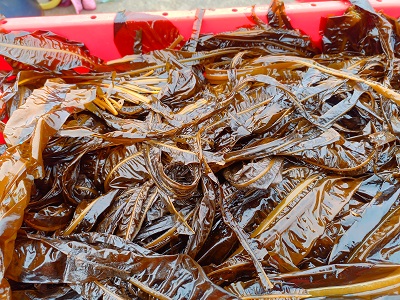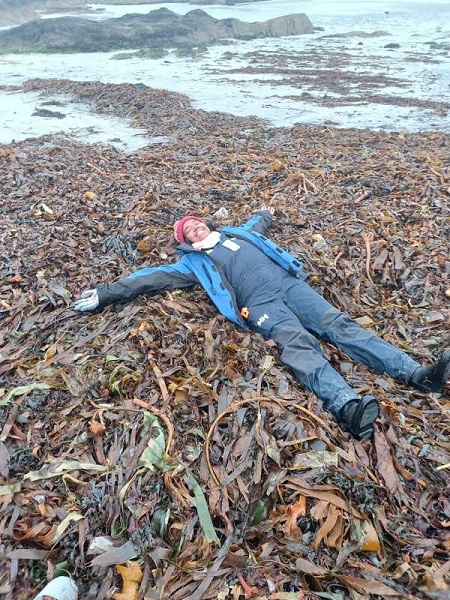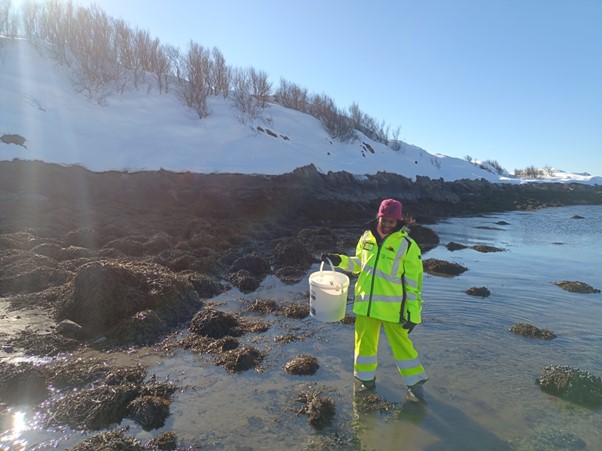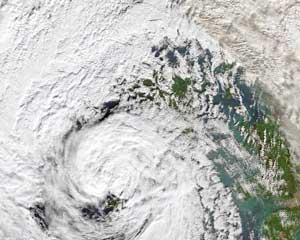By improving methods for processing kelp, we can support seaweed farmers in a growing market. It’s a quest that’s taken Priya Pollard - from the UCD School of Biosystems and Food Engineering - from Ireland to the Arctic Circle.
Improving methods for processing kelp can help seaweed farmers preserve large amounts of kelp quickly, easily, and cheaply – and in a more environmentally friendly way because they are using less fossil fuel-powered heat. Improving processing methods and advancing research for processing kelp can also help support Ireland’s seaweed farmers in a growing market.
Research by Priya Pollard (School of Biosystems and Food Engineering) is focused on optimising the ensiling techniques needed to produce a high-value kelp product. Priya’s research has taken her from the southwest tip of Ireland all the way to the north of Norway within the Arctic Circle.
What is kelp?
 |
|
Winged Kelp, Alaria esculenta, harvested at |
People often ask what the difference is between seaweed and kelp. Essentially, a kelp is a subset of seaweed. There are three types of seaweed: green (Chlorophyta), red (Rhodophyta) and brown (Phaeophyta). Of these three groups, kelps fall into the brown group. So, all kelps are seaweed, but not all brown seaweeds are kelps.
To qualify as a kelp, the seaweed must tick a few boxes. Firstly, it must be brown (and there are many different shades of brown seaweed). Secondly, it must be large and have a long, tough stalk, similar to a stem. Thirdly, it must have a broad frond. A frond is the part of the kelp that looks similar to a leaf.
Although kelps are often referred to as ‘underwater plants’, they have no vascular system, i.e., they have no roots, no real stems and no real leaves. Evolutionary speaking, these similarities come from convergent evolution.
There are around 30 different species of kelp which can range in size from several centimetres to over 50 metres long (around the length of the Leaning Tower of Pisa, half a football pitch, 10 canoes or 16 Siberian tigers) However you compare it, kelps can be big!
Uses for kelp
 Kelps grow in underwater ‘blue’ forests, and can be compared to terrestrial forests in terms of their structure, biodiversity, and the valuable ecosystem services they provide. Kelps require nutrient rich water to grow, and just as trees provide homes for birds and insects, kelp forests provide shelter for marine organisms, like juvenile fish, small crustaceans and molluscs.
Kelps grow in underwater ‘blue’ forests, and can be compared to terrestrial forests in terms of their structure, biodiversity, and the valuable ecosystem services they provide. Kelps require nutrient rich water to grow, and just as trees provide homes for birds and insects, kelp forests provide shelter for marine organisms, like juvenile fish, small crustaceans and molluscs.
While kelp provides underwater ecosystem services, they also have lots of other uses. As far back as the 18th century in Ireland, kelp played an important part in some industries when it was used to make glass, and to bleach cloth. Today, kelp is sold as a food product and can be processed for use in a variety of everyday products such as toothpastes, shampoos, salad dressings, puddings, cakes, dairy products, frozen foods, makeup and even pharmaceuticals.
Research to support kelp farmers
In Ireland the common kelp species are winged kelp (Alaria esculenta), oarweed (Laminaria digitata), tangle (Laminaria hyperborean) and sugar kelp (Saccharina latissima). Winged kelp and sugar kelp are commonly grown by seaweed farmers along the Irish coast because they large in size extremely quickly. When the kelp is harvested, it needs to be processed quickly since the quality of the biomass begins to degrade hours after harvesting.
Farmers currently dry their seaweed in large ovens, but with more and more farmers producing more and more kelp, increasing drying cost (energy prices), and the need to be more sustainable, drying alternatives are needed. Putting it into perspective, in 2019 Ireland produced 42 tonnes of seaweed, recent projections from BIM suggest that with current expansion trends in the sector, by 2030, Ireland could produce upwards of 35,500 tonnes of biomass.
To this end, my research is focused on optimising the ensiling techniques needed to produce a high value kelp product. If kelp ensiling is successful, seaweed farmers can preserve large amounts of kelp quickly, in a relatively easy and cheap fashion. This should also be more environmentally friendly because they are using less fossil fuel-powered heat.

My PhD research has taken me from Trinidad and Tobago in the Caribbean, up to the southwest tip of Ireland and also all the way to the north of Norway, within the Arctic Circle, to look at the applications of ensiled kelp. In Norway, I researched kelp as a biostimulants and as a food source. If you are interested, you can find a vegan seaweed scone recipe of my creation.
There are many factors that go into making a good grass silage, and to make a good seaweed silage, all the ‘grass’ factors must be considered as well as all the novel seaweed factors. Needless to say, this has taken a long time to get right. Some of the challenges include: a high moisture content and seasonality. Kelps are highly seasonal in terms of biomass availability and their chemical composition also varies from species to species. My preliminary results have indicated that it is possible to ensile various kelps and that several high value products are preserved and created in the process. The ensiled products contains relatively high amounts of mannitol, lactic acid and alginate which are all useful products that can be biorefined.
The full potential for ensiled seaweed is unknown, but for starters, it can be biorefined for lactic acid and other compounds, or used for pharmaceutical extractions, or maybe applied as a fertilizer or possibly as an animal feed additive. Currently Ireland has one of the most productive seaweed industries in Europe, but the kelp industry only makes up a small portion of it. This is due to a number of factors, including accessibility and the cost of drying facilities. Improving processing methods and advancing research on the applications of ensiled kelp, we can support Ireland’s seaweed farmers in this growing market.
Essentially, kelps are a wonderfully interesting and valuable resource. They provide for the marine ecosystem and can also provide directly to us humans. Compared to plants there has been very little research undertaken on kelp and seaweed in general. As we continue to explore the wonders of kelp, we must do so sustainably and circularly to avoid repeating the mistakes of the past.
Essay first published 1 September 2023.
About the author
Priya Pollard is from the UCD School of Biosystems and Food Engineering and is based at the Bantry Marine Research Station, Co. Cork as part of the Innovative Training Network (INT) AgRefine. Her research involves ensiling kelp to preserve its biomass, as an alternative to oven drying. Ms. Pollard also holds a MSc. Integrated Coastal and Ocean Management (ICOM) from the University of Trinidad and Tobago, Marine Sciences Department and a BSc. Major Biology and Minor Environmental Biology from the University of the West Indies, St. Augustine Campus.
To connect with Priya and learn more about her research, click here and select your preferred platform to do so https://linktr.ee/priya.
About the series
The A-Z of Environmental and Sustainability Research is a new series of short essays by UCD postdoctoral and postgraduate researchers, technical and research support staff, about their work. The series is developed and curated by the Earth Institute Associate Member Committee led by Hannah Gould, a PhD student at BiOrbic and the UCD School of Architecture, Planning and Environmental Policy, and Earth Institute Communications and Engagement Officer Liz Bruton. If you'd like to submit a piece for the series do get in touch!
Find out more about the Anthropocene with Nick Scroxton, Bees with Katherine Burns, Cannabis with Caroline Dowling, Degrowth with Ciarán O'Brien, Education with Georgina Fagan, Finance with Shane McGuinness, Gaia with Federico Cerrone, Hydrometry with Kate de Smeth, Innovation with Hannah Gould, Justice with Lauren Minion, and Kelp with Priya Pollard in our latest essays.
Further reading
Lange, L., Bak, U.G., Hansen, S.C.B., Gregersen, O., Harmsen, P., Karlsson, E.N., Meyer, A., Mikkelsen, M.D., Van Den Broek, L., Hreggviðsson, G.Ó. (2020) ‘Opportunities for seaweed biorefinery’, Sustainable Seaweed Technologies, 3–31. https://doi.org/10.1016/B978-0-12-817943-7.00001-9
Review of the Irish Seaweed Aquaculture Sector and Strategy for its development to 2023 (2023): https://bim.ie/wp-content/uploads/2023/05/BIM-IMAS-Strategy.pdf


.jpg)